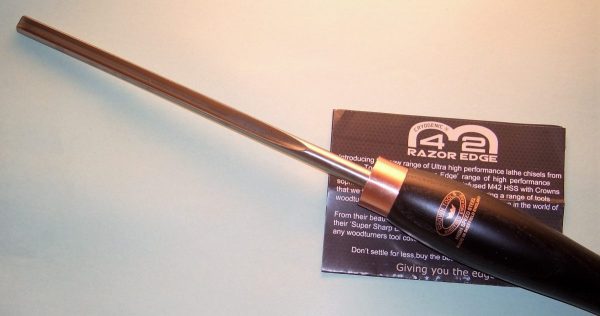Isn't the difference in the tang another characteristic of a continental gouge? I'm not being a smart a$$ in new to turning and am truly seeking knowledge.
Gregory
Gregory
I don't believe the tang is an intrinsic property of any gouge style – it's the profile of the sharp business end that counts, as it were. For example, there are SRGs with narrow tangs but the more recent thing is to have a much more robust, large-diameter tool end for SRGs as the tang was a weak point in a bad catch. But the tool's geometry is the same for both tang styles.Isn't the difference in the tang another characteristic of a continental gouge? I'm not being a smart a$$ in new to turning and am truly seeking knowledge.
I knew this about the SRG, but didn't about the contental gouge. I thought they were machined from round stock. Thanks for the information, I appreciate it very much.continental" gouges, and spindle roughing gouges, both start life as flat stock
As John Whitley said, it isn't so much the tang or the stock that makes a continental gouge a continental gouge - It's the profile of the flute and cutting edge. A Continental gouge could be made from round bar stock , if you cut the flute properly (relatively shallow) - Look at the photo Randy Anderson posted, you can see how you could mill a continental gouge from round bar stock (though rarely can I imagine it to be worth it given the amount of steel you'd have to cut away to form the flute both top and bottom) and then of course the fingernail grind to the cutting tip. - Technically you could turn a SRG into a continental gouge by grinding down the top of the flute a bit lower and then giving it a fingernail grind instead of the straight-across grind of a SRG... There's lots of spindle gouges milled from round bar stock, but they tend to have a much thicker heel than a Continental once you sharpen them up.Isn't the difference in the tang another characteristic of a continental gouge? I'm not being a smart a$$ in new to turning and am truly seeking knowledge.
Gregory
Chris Hoehle recommended the Crown M42 continental gouges up thread.If there was an M42 or V10 continental style gouge out there
Indeed -- they're very useful for turning pieces for the Windsor chairs I buildIf there was an M42 or V10 continental style gouge out there, I would add them to my arsenal. I am not that much of a spindle turner, but can see them being handy. The preferred tool of the old school bodgers.
robo hippy
Great name for a band: Old School Bodgers! Let the gen whatevers try to figure 'bodgers' outIf there was an M42 or V10 continental style gouge out there, I would add them to my arsenal. I am not that much of a spindle turner, but can see them being handy. The preferred tool of the old school bodgers.
robo hippy
If I could find a crown m42 continental in 30mm I would snag it up in the drop of a hat. Alas, sorby makes one that's not even categorized as m2.... Pass again.Chris Hoehle recommended the Crown M42 continental gouges up thread.


 www.glennlucaswoodturning.com
www.glennlucaswoodturning.com
